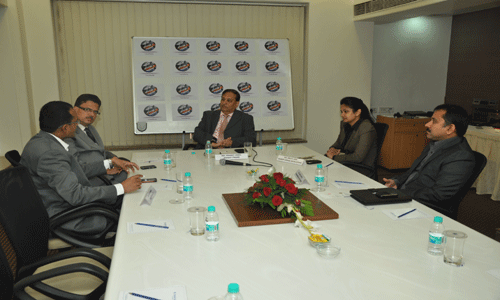Track2Realty Roundtable
Venue—Hotel Kohinoor Continental
Moderator—Pranay Vakil, Chairman, Knight Frank India
Panelists—Kruti Jain, Director, Kumar Urban Developers
Sunil Dahiya, MD, Vigneshwara Developers
Atul Modak, Head, Kohinoor City
Ravi Sinha, CEO & Managing Editor, Track2Realty
 Pranay Vakil: Let’s start by introducing ourselves. I am Pranay Vakil, Chairman of Knight Frank India. We are a brokerage and consultancy group, positioned as second in the business.
Pranay Vakil: Let’s start by introducing ourselves. I am Pranay Vakil, Chairman of Knight Frank India. We are a brokerage and consultancy group, positioned as second in the business.
Kruti Jain: I am Kruti Jain, Director of Kumar Urban Developers, earlier known as Kumar Builders. I am actually third generation in the business of real estate.
Sunil Dahiya: I am Sunil Dahiya, Managing Director of Gurgaon-based Vigneshwara Developers in Delhi-NCR. I am first generation real estate developer.
Atul Modak: I am Atul Modak and work for Kohinoor Group which is into a number of businesses, including real estate.
Ravi Sinha: I am Ravi Sinha, CEO and Managing Editor of Track2Realty. We are India’s first and only real estate e newspaper as against other realty portals with different focus area.
Pranay Vakil: How are other realty portals different than you?
Ravi Sinha: We are not into property transaction. Our focus area is news, views and analysis. And now we are coming out with first ever real estate yearly handbook-Focus 2012.
Pranay Vakil: Ok. Let me start the discussion with sharing a story. When I was very young, I happened to read a book which defined money. Money is a matter of functions four – a medium, a measure, a standard, a score. It was something that has been stuck in my mind for all this time. It stuck a chord with me because of the various functions money has to play and when I came to real estate, I realized that money is indeed important. When I look at developers, I ask myself what is a developer? My understanding says that he is just a coordinator. He has the raw material, the land. And the land is secured either directly or in a JV. Then the developer possibly could organize the architects, the permissions and all that and then they get someone like Knight Frank to market it. And the fourth part was funding.
Out of all this, you could buy any of the services. But when it comes to funding, it becomes more difficult. And for funding, all developers look at all kinds of solutions. Some within the box and some outside it. The needs and solutions are different for listed and unlisted companies. But as things went along, a lot of out of the box thinking emerged. Obviously, for listed companies, they kept the debt equity in mind and raised more capital if it meant that they could deploy it at a rate higher than they could provide the shareholders. When it came to debt, they hit the wall because not many banks were willing to fund the land purchase. They were only willing to fund the project.
Then came a funding through PE and real estate funds in the last few years, starting with HDFC, Kotak etc. I call it wave one, because all of these funds are close ended, 5-7 years and most of them are completing the 5 year term now. It is both good and bad. The bad thing is that they have to get out because they have to close the fund and if they have to get out then it may or may not be the right time to exit. The good thing is there are new funds which want to get into the business. So what the existing players want to sell, someone may want to buy it. Again, the good thing is this is a laundered asset, so to say. Some fund has had it for 5 years, titles are good, and so the scrutiny that is applied is minimal.
Then there are people who have tried completely different ways of funding. For companies that we know who found REIT outside of India, may be in Singapore and through this mechanism they tried to get money here. Some succeeded because they had base in Singapore. Others tried to create a REIT like apparatus to get money here, they found that it was not as easy as it was.
Then there was a huge amount of expectation within India that something like this would be allowed. We have been waiting for something like REIT to happen. The guidelines have been published some three years ago. What we find is that when the guidelines were still under discussion, came the mutual funds from backdoor and got an entry straight away as a legit way of raising funds while the REIT stayed in a discussion/draft stage and remained as something which as of now, is not permitted in India. I just returned from the US and I happened to have met a lot of people who want to come into India and are just waiting for the policies to change a little.
Talking of out of box thinking, there are people who have gone for AIMS listing. Have they succeeded? If you go by the quotes available with lenders, a lot of them are quoted below par, some of them are quoted at 10% of the issue. And AIMS have note necessarily succeeded. But there was a time when people tried raising money through that route as well. Another route many developers have tried is raising money against receivables. I can understand if the product is sold, you have a receivable. You do a discounting of the receivable and you raise the money. But I have noticed cases where future receivables are discounted. That means there is something which is not yet sold but will be in the future and you create a receivable. You don’t even know the price of that but you get to raise money against those receivables. I am not talking of discounting of rentals, just the funding of the projects.
Let me also tell you that people have been aggressive in raising money. They have raised money against sales with a guarantee that if the price falls, they will buy it back. Now who will buy into those projects? Some of them are actual users, others are investors. They wanted a protection on the bank’s side that if the prices fall, of course there is a margin of about 20%, if the prices fall more than that, they will buy back. Why 20% – because about 10% is the expense in buyback, brokerages, paperwork etc. If you begin to suffer beyond 20%, then they are willing to buy back at the price you bought it
It is a very effective way of raising money because a particular developer in Mumbai who had employed this method was able to sell 45 flats within 3 weeks at a time when the markets were particularly bad.
One of the things which is important for all developers to know is that depending upon what you do, your peak requirement of funding can be very different. On the same plot if you do residential development, your requirement could be x, but if you do a mall, your requirement will be 3x. Because you will not be able to sell it under construction and if you sell it under construction, if the mall is a disaster, your funds go down. Sometimes people have made this mistake, going for a mall and not a residential development. Losing track of what kind of funding is required, that is calling for disaster.
I think this is the general background I would like to put before you. This is the general way that the developer community operates. They are open to new things, all developers are saying if there is a way of raising money.
So the first question I would like to ask to this panel is what is the ideal debt equity that one should work with, something that the lender would be willing to accept?
…..to be continued





